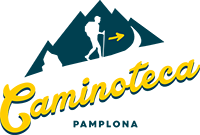At twilight, or taking advantage of the subtle colours of dawn is the best time to discover one of the loveliest and most evocative churches on the Pilgrim’s Way to Santiago de Compostela: the church of Our Lady of Eunate (1170), a simple, unique and mysterious building. It stands in solitude just before you reach Puente la Reina in the middle of a flat, open landscape which takes on the colour of sunflowers in summer. Its octagonal layout and the cloister that surrounds it differentiate it from any other Romanesque church.
The continuing mystery about its origin and its unsettling interior have aroused great interest in this church, which has been a pilgrims’ hospital, a funeral chapel, a beacon and guide for walkers, a place of Christian worship and a telluric sanctuary for those seeking esoteric powers. Come and be fascinated by its enigmatic geometry and breathtaking interior, and try to guess the meaning of its name in Basque: “one hundred doors”.
Built in 1170, its origin is unclear. Some historians have suggested the possibility that it was the work of the Knights Templars and a hospital of the Order of St. John, while popular tradition attributes its construction to a queen or noble lady whose tomb lies beneath the stones, in order to serve as her funeral chapel. The discovery of graves between the columns of the cloister and the remains of a tomb at the foot of the entrance door, amongst which a pilgrim’s shell was found, confirms that the church was a cemetery for pilgrims. Its octagonal layout, like the Church of the Holy Sepulchre in Jerusalem and two other buildings on the Pilgrim’s Way, is encircled by a beautiful gallery of 33 arches with decorative capitals. The harmony of the octagonal layout is broken by the pentagonal apse and a small square walled tower on the side of the epistle. Openwork and blind windows alternate along the exterior walls, and there are two access doors; the north one, very highly decorated, facing the road to Santiago, and another simpler door facing west.
Take a stroll around the gallery before going into the inner temple, which is simple with certain elements of Muslim influence. Let your eyes adapt gradually to the dim light and feel the sense of spirituality and devotion that envelop the church. You can see two heights on the masonry walls and at each angle two columns are superimposed. The sobriety of the interior is only ostensible, as the columns have 26 decorated capitals. The octagonal vault is held up by eight ribs with different angles, which shows that the eight sides of the church are all different. In the semicircular apse, of tremendous architectural richness, the oldest sculptural elements of the church can be found.
Very close to this medieval church, in Olcoz, is the church of San Miguel (St. Michael), which has an identical door to the church at Eunate, but in reverse. Legend tells that a master stonemason who had been commissioned to build the door at Eunate was annoyed because while he was absent a giant with supernatural powers beat him to it and completed the work. The abbot challenged the stonemason to build a similar church in the same space of time, three days, a feat he achieved with the assistance of witches, serpents and magic spells. Although the result was an identical doorway, it was inverted. On seeing the doorway, the giant flew into a rage and hit it with such force that it was sent flying to Olcoz.
This website uses cookies so that we can provide you with the best user experience possible. Cookie information is stored in your browser and performs functions such as recognising you when you return to our website and helping our team to understand which sections of the website you find most interesting and useful.





